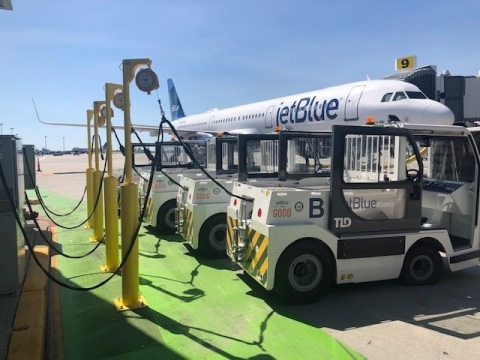
- JetBlue has introduced electric-powered ground service equipment fleet at New York’s JFK International Airport to cut four million pounds of CO2 greenhouse gas emission per year.
- The measure will also help cut ground fuel usage by approximately 200,000 gallons of ground fuel a year, improve the airline’s bottom line and help reduce noise.
- JetBlue’s electric ground service equipment (eGSE) will be the largest of its kind by any carrier at JFK.
- “Converting our ground service equipment to electric will not only help reduce our emissions, it will help with operational efficiencies including safer and quieter equipment for our ground operations crewmembers. JetBlue has set ambitious goals to manage our CO₂ emissions below the wing by transitioning our ground service equipment to electric power sources where feasible. This is one part of our overall efforts which primarily focuses on reducing our emissions from flying,” Joanna Geraghty, President and Chief Operating Officer, JetBlue, said.
- The airline will use 38 charging hubs with 118 charging ports across all gates of Terminal 5 (T5) to charge the new eGSE fleet of 59 electric bag tugs and 59 electric belt loaders.
- In future, JetBlue could introduce a fleet of eGSE in Boston with construction and the installation of equipment scheduled for 2020.
PRESS RELEASE
JetBlue (Nasdaq: JBLU), New York’s Hometown Airline®, today announced that the airline is converting its fleet of baggage tractors and belt loaders – the largest part of its ground service equipment fleet at New York’s JFK International Airport – to electric powered. With support from the Port Authority of New York and New Jersey and the New York Power Authority (NYPA), JetBlue is rolling out the largest fleet of electric ground service equipment (eGSE) of any airline at JFK.
JetBlue is constantly looking for more efficient technologies and sustainable fuel options. Electric bag tugs and belt loaders will replace the previous vehicles which were powered by gasoline. The new eGSE equipment will help reduce noise, improve energy efficiency and lessen JetBlue’s environmental footprint.
By converting to eGSE, additional benefits for JetBlue will include:
- Cutting four million pounds of CO2 greenhouse gas emission (1,700 metric tons) per year – the equivalent of the amount of CO2 absorbed by 2,100 acres of U.S. forests
- Reducing ground fuel usage by approx. 200,000 gallons of ground fuel a year
- Improving its bottom line with more than $500,000 in ground fuel savings annually
“Converting our ground service equipment to electric will not only help reduce our emissions, it will help with operational efficiencies including safer and quieter equipment for our ground operations crewmembers,” said Joanna Geraghty, president and chief operating officer, JetBlue. “JetBlue has set ambitious goals to manage our CO₂ emissions below the wing by transitioning our ground service equipment to electric power sources where feasible. This is one part of our overall efforts which primarily focuses on reducing our emissions from flying.”
JetBlue purchased and wholly owns the vehicles. Immediate gains from this conversion include zero tailpipe emissions which will reduce carbon monoxide, ozone precursors and particulate matter. The electric equipment brings additional safety features including a new aircraft detection system to reduce aircraft damage. With this conversion more than 40% of JetBlue’s motorized vehicles at JFK are now electric.
To charge the new eGSE fleet of 59 electric bag tugs and 59 electric belt loaders, JetBlue has phased in 38 charging hubs—with 118 charging ports—across all gates of Terminal 5 (T5). Support for the charging stations was provided by the Port Authority of New York and New Jersey through a $4 million Voluntary Airport Low Emissions Program (VALE) grant, the first awarded to the Port Authority of New York and New Jersey from the Federal Aviation Administration (FAA). The grant accounts for 75 percent of the total cost of the charging stations. JetBlue provided a significant portion of the remaining cost for the charging stations with NYPA contributing an additional grant.
VALE grants are awarded to airports to help improve air quality and provides air quality credits for future development. Created in 2004, VALE helps airport sponsors meet their state-related air quality responsibilities under the Clean Air Act. VALE grants are expected to reduce ozone emissions by 1,192 tons per year over the next five years. This is equivalent to removing 66,550 cars and trucks off the road each year.
Rick Cotton, Executive Director of the Port Authority of NY and NJ, said, “The installation of 38 fast-charging hubs will not only contribute to improved air quality across the region, but it will also bring modern and advanced technological solutions to JFK Airport. We’re grateful for NYPA’s and JetBlue’s partnership as we continue to make remarkable progress in reducing our carbon footprint.”
Aligned with JetBlue’s efforts for long-term energy solutions, NYPA partnered with the airline and the Port Authority of New York and New Jersey by providing additional funding for the charging stations.
“NYPA is proud to partner with the Port Authority and JetBlue on this exciting initiative to fully electrify JetBlue’s terminal at JFK International Airport,” said Gil C. Quiniones, NYPA president and CEO.NYPA, under the leadership of Governor Cuomo, is committed to transitioning New York State into a clean energy economy and this public-private initiative at one of the world’s busiest airports is a significant step toward realizing that goal.”
What’s next for eGSE? JetBlue has long been operating eGSE equipment in its ground operations in Long Beach, Calif. The airline is now setting its sights on its other focus cities to make the switch for enhanced operational efficiency. Next, a significant fleet of eGSE is expected to be introduced in Boston with construction and the installation of equipment slated for 2020.
Commitment to the Environment – With an aviation industry-wide goal to cap net greenhouse gas growth from 2020 onward, JetBlue remains committed to more efficient and environmentally responsible processes and technologies including using less fuel which saves money, strengthens the bottom line and reduces the airline’s impact on the environment – protecting the natural places customers want to visit. JetBlue continues to explore ways to reduce its greenhouse gas emissions exposure, including a focus on renewable jet fuel as a long-term business strategy. Investments in renewable energy sources are key to a lower carbon future which will take time and industry cooperation to come to fruition.
The airline focuses on issues that have the potential to impact its business. Customers, crew members and community are key to JetBlue’s sustainability strategy. Demand from these groups for responsible service is one of the motivations behind changes that help reduce the airline’s environmental impact.




